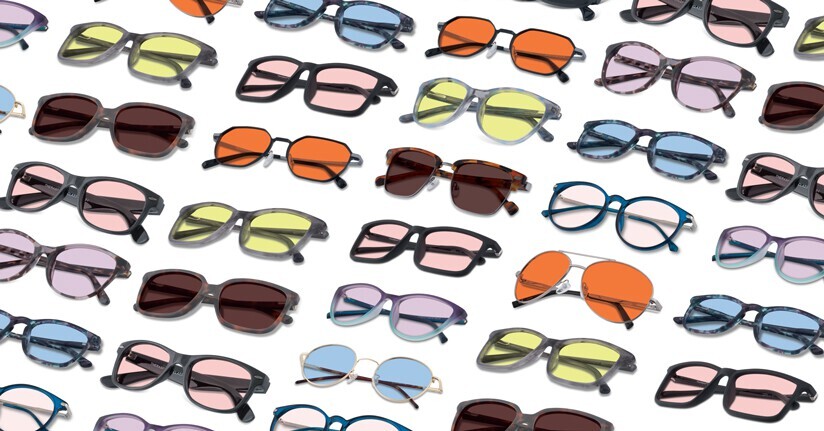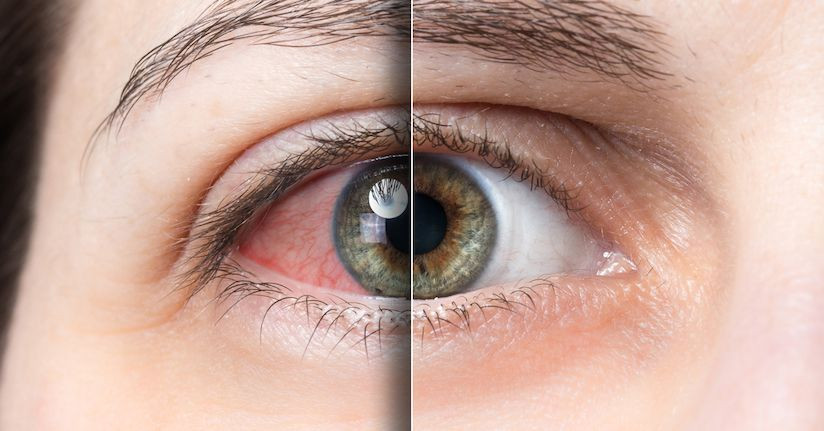Dry Eye: A Leading Cause of Light Sensitivity
Dry eye and dry eye disease are a common condition affecting potentially up to one-third of the worldwide population and may be even more prominent with age.1 Of course, the most prevalent symptoms are felt in and around the eyes, such as: ocular burning, eye fatigue, stinging, redness and dryness. In addition, photophobia or painful light sensitivity is another frequent side effect associated with dry eye, and in many cases exposure to light can bring on symptoms of the condition too. These are the ways patients experience and are impacted by sensitivity to light.
Prevalence of Dry Eye and Light Sensitivity
It has been reported that dry eyes are one of the leading causes of light sensitivity. In fact, one study showed that three out of every four individuals with dry eye also reported this extreme aversion to light. Interestingly, women are more likely to endure this symptom than men.2,3 And it can even persist long after dry eyes have cleared, such as through the development of corneal neuropathic pain—which refers to painful ocular reactions to stimuli that do not normally cause pain—or due to some other pathology.
Unfortunately, this means exposure to light can be a reliable trigger of dry eye symptoms too. Although there is conflicting evidence about specific light-related triggers,4 they can include:
- Fluorescent lighting
- Computer and device screens
- Watching television
- Bright sunlight
- Flashing or flickering lights
- Other sources with high amounts of blue light
Not surprisingly, these can be compounded by other environmental factors, such as low humidity, high wind conditions or even air conditioned spaces. Many dry eye patients also have a reduced threshold for pain, which just adds to the intensity of their symptoms, including light sensitivity.
Why Sensitivity to Light Accompanies Dry Eye
Medical researchers do not have an exact understanding of why photophobia occurs in dry eye patients, but some have suggested that it stems from inflammation of the trigeminal nerve near the cornea.5 Central sensitization in the nervous system may also be to blame as well as more traditional processes that underlie photophobia—notably the activation of photosensitive cells in the eye that are known to transmit light to the brain.1
Furthermore, dry eye disease often manifests with other conditions, such as migraine or traumatic brain injury, which can complicate and contribute to the sensitivity to light experienced by so many. We explore the most likely comorbidities that can lead to dry eye-related light sensitivity below.
Migraine
People with migraine have numerous visual symptoms associated with their attacks, including higher levels of light sensitivity and dry eye-like symptoms. As many as 90% of migraine sufferers have photophobia and nearly 50% shows signs of dry eye, which is significantly elevated from the general population.6 This unfortunately can negatively impact migraine frequency, severity of symptoms and disability reported.
Traumatic Brain Injury
The effects of traumatic brain injury (TBI) can be vast, however dry eye disease seems to be a common problem. And veterans with a TBI may be at particular risk, with 37% also being diagnosed the eye disorder. A history of a prior brain injury was also associated with an increase in frequency of ocular and other eye pain.7 Similarly, painful sensitivity to light is a byproduct of both of these issues and may be compounded when both are present.
Sjogren’s Syndrome
Those with the autoimmune disease, Sjogren’s syndrome, have severe dryness of the eyes early and often; moreover, as many as two-thirds of patients must also deal with neurological problems like photophobia, headaches and/or migraine attacks.8 Since Sjogren’s syndrome causes dryness of the glands and membranes in the eyes, dry eye is the most recognized symptom of the disease, and therefore enhances the risk of bright light intolerance.
Impact of Light Sensitivity from Dry Eye
The impact of dry eye disease coupled with prominent light sensitivity can be profound. Sadly, patients with both of these issues are more likely to have other severe symptoms that persist longer. In general, disturbed vision and lower pain tolerance are also hallmarks of dry eye, which can contribute to emotional consequences and significantly reduce quality of life.1,9 Photophobia can also lead to significant physical and emotional burden, particularly when aversion behaviors cause social isolation, depression and/or anxiety.
What is most unfortunate is that this hypersensitivity to light stimuli may reduce the effectiveness of traditional dry eye remedies, such as artificial tears.1
Remedies for Dry Eye Light Sensitivity
We have discussed some of the best remedies for dry eye in a previous post, but we want to share some tips for specifically improving the light sensitivity associated with eye dryness.
Identify comorbid conditions
Your doctor can evaluate the totality of your symptoms to determine if you have any of the frequently co-occurring medical conditions previously discussed. This may help open up the door to new treatment methods, particularly if your light sensitivity is resistant to dry eye specific remedies.
Don’t wear sunglasses indoors
Professionals have repeatedly warned against the use of sunglasses indoors because it can make your photophobia worse the longer you wear them. The same is true of prolonged avoidance of light through behavioral means (such as by constantly skipping out on social obligations due to lighting concerns), which can also contribute to the development of emotional symptoms.
Try indoor light sensitivity glasses
Specialty glasses for light sensitivity, which can be tinted for indoor use, are a far better alternative than normal sunglasses; not only are they lighter (and thus do not risk dark adaptation), but they filter specific wavelengths of blue light that can worsen photophobia caused by dry eye. Patients also report that these glasses give them the freedom to be in the light and participate in important activities.
Opioids as a last resort
More extreme measures, such as the direct injection of opioids in a part of the nervous system known as the superior cervical ganglion may reduce ocular pain and light sensitivity in individuals with diminished tear production.10 Generally, this option would be considered only if numerous other physical and behavioral approaches failed AND if the pain was considered severe and unrelenting. It’s also important to note that the evidence here is small and there can be other negative consequences to opioid-based therapies, so it is always best to consult with your doctor about the risks.
References:
1Messmer EM. The Pathophysiology, Diagnosis, and Treatment of Dry Eye Disease. Deutsches Ärzteblatt International. 2015;112(5):71-82. doi:10.3238/arztebl.2015.0071.
2Galor A, Levitt RC, Felix ER, Sarantopoulos CD. What can photophobia tell us about dry eye? Expert review of ophthalmology. 2016;11(5):321-324. doi:10.1080/17469899.2016.1222905.
3Vehof J, Sillevis Smitt-Kamminga N, Nibourg SA, Hammond CJ. Sex differences in clinical characteristics of dry eye disease. Ocul Surf. 2018 Apr;16(2):242-248. doi: 10.1016/j.jtos.2018.01.001. Epub 2018 Jan 6.
4Iyer JV, Lee S-Y, Tong L. The Dry Eye Disease Activity Log Study. The Scientific World Journal. 2012;2012:589875. doi:10.1100/2012/589875.
5Digre KB, Brennan KC. Shedding Light on Photophobia. Journal of neuro-ophthalmology : the official journal of the North American Neuro-Ophthalmology Society. 2012;32(1):68-81. doi:10.1097/WNO.0b013e3182474548.
6Wong M, Dodd MM, Masiowski P, Sharma V. Tear osmolarity and subjective dry eye symptoms in migraine sufferers. Can J Ophthalmol. 2017 Oct;52(5):513-518. doi: 10.1016/j.jcjo.2017.02.019. Epub 2017 May 26.
7Lee CJ, Felix ER, Levitt RC, et al. Traumatic brain injury, dry eye and comorbid pain diagnoses in US veterans. British Journal of Ophthalmology Published Online First: 26 August 2017. doi: 10.1136/bjophthalmol-2017-310509.
8Morreale M, Marchione P, Giacomini P, et al. Neurological Involvement in Primary Sjögren Syndrome: A Focus on Central Nervous System. Hu D, ed. PLoS ONE. 2014;9(1):e84605. doi:10.1371/journal.pone.0084605.
9Vehof J, Kozareva D, Hysi PG, Harris J, Nessa A, Williams FK, Bennett DL, McMahon SB, Fahy SJ, Direk K, Spector TD, Hammond CJ. Relationship between dry eye symptoms and pain sensitivity. JAMA Ophthalmol. 2013 Oct;131(10):1304-8. Doi: 10.1001/jamaophthalmol.2013.4399.
10Fine PG, Digre KB. A controlled trial of regional sympatholysis in the treatment of photo-oculodynia syndrome. J Neuroophthalmol. 1995 Jun;15(2):90-4.

TheraSpecs® Glasses for Light Sensitivity
Find the glasses that fit your needs and lifestyle, and stay protected from screens, fluorescents, unwanted blue light, sunlight, flashing lights, and more.
Shop Now



